Osprey Roundup
There wasn’t a Roundup for January because nothing reached me from
Osprey, there were only a few books published in December so they combined
the two months. So this month I’ll look at both months’ books.
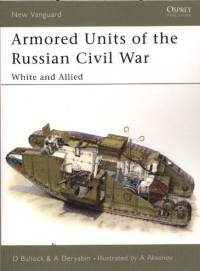 New
Vanguard 83, Armored Units of the Russian Civil War, White and Allied,
by D Bullock and A Deryabin, illustrated by A Aksenov, ISBN 1-84176-544-9,
48 pages. New
Vanguard 83, Armored Units of the Russian Civil War, White and Allied,
by D Bullock and A Deryabin, illustrated by A Aksenov, ISBN 1-84176-544-9,
48 pages.
Here’s a good book to use for alternative ideas on markings for
WW1 tank models – the British Mark IV and V heavy tanks and the Medium
A Whippet are available in plastic and so is the Renault FT, and there
are a number resin kits of armoured cars are availablef rom East European
makers. Coverage includes useful information about their deployment and
use as well as a nice selection of contemporary photographs – and
that’s just the first half of the book. The second half deals with
armoured trains, and is just as good in text and photographic selection.
The colour plates cover a good mix of armoured cars, tanks and armoured
trains, with interesting markings, and there are text sections on colour
schemes and markings as well as the usual extended captions for the plates.
A second volume will deal with the Red Russian tanks, armoured cars and
armoured trains. Highly recommended!
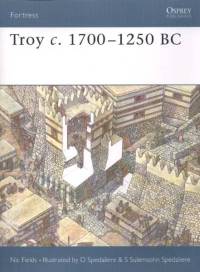 Fortress
17, Troy c. 1700-1250 BC, by Nic Fields, illustrated by D Spedaliere and
S Sulemsohn Spedaliere, ISBN 1-84176-703-4, 64 pages. Fortress
17, Troy c. 1700-1250 BC, by Nic Fields, illustrated by D Spedaliere and
S Sulemsohn Spedaliere, ISBN 1-84176-703-4, 64 pages.
The new Fortress title is fascinating! If you’ve seen the TV series
with Michael Wood, or encountered the Homeric tale of the Iliad, already
seen one of the films about the siege of Troy or simply want some background
to the new film that we’ve all heard about, this is the book to get.
Excellent explanatory text about the site and the successive cities that
grew on top of each other’s ruins, and clear photographs of the archeological
finds, is backed up by superb plates showing the reconstructed appearance
of the city. Be prepared to pick holes in the film sets! Recommended to
all fans of ancient history too, and of course extremely useful to modellers
of Bronze Age Greek warriors who want them to have proper settings.
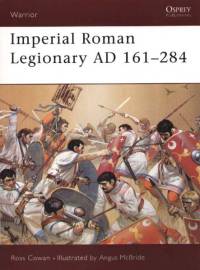 Warrior
72, Imperial Roman Legionary AD 161-284, by Ross Cowan, illustrated by
Angus McBride, ISBN 1-84176-601-1, 64 pages. Warrior
72, Imperial Roman Legionary AD 161-284, by Ross Cowan, illustrated by
Angus McBride, ISBN 1-84176-601-1, 64 pages.
Following earlier Osprey titles about the Legions’ clothing and
equipment, here is a good book about the recruitment, training and battles
of the Imperial Legionaries. Great stuff, detailed and informative! Angus
McBride’s colour plates are as good as ever, and it’s worth
buying the book just to have them. Very highly recommended to anyone interested
in ancient Rome’s late Imperial period, either for its history or
simply modelling the Legionaries.
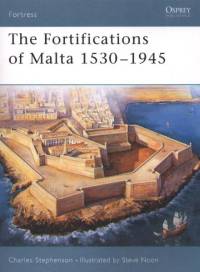 Fortress
16, The Fortifications of Malta 1530-1945, by Charles Stephenson, illustrated
by Steve Noon, ISBN 1-84176-693-3, 64 pages. Fortress
16, The Fortifications of Malta 1530-1945, by Charles Stephenson, illustrated
by Steve Noon, ISBN 1-84176-693-3, 64 pages.
We’ve already had an Osprey Campaign title on the Siege of Malta
by the Turks, and here is the detail of how the fortifications were laid
out and built over a long period. The book starts with the arrival of
the Knights Hospitaller on Malta and the forts and walls they built to
hold off the Turks, then looks at the British additions in the 19th Century
and finally at the works added in WW2. Anyone planning a holiday on Malta
will find this book a splendid guide to the fortifications – there
are far more to see than just those of Valetta. The plates and plans cover
the whole period of interest, and are ably backed up by good photographs.
Recommended for historic interest and modellers as well as to tourists!
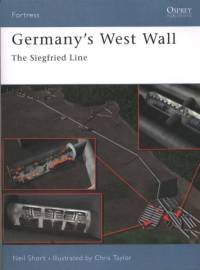 Fortress
15, Germany’ West Wall, The Siegfried Line, by Neil Short, illustrated
by Chris Taylor, ISBN 1-84176-678-X, 64 pages. Fortress
15, Germany’ West Wall, The Siegfried Line, by Neil Short, illustrated
by Chris Taylor, ISBN 1-84176-678-X, 64 pages.
Perhaps a bit more esoteric than other Fortress titles but very interesting
anyway, this is the story of how the Siegfried Line was built, garrisoned,
defended, and eventually breached by the British and US Armies. Actually
the building was slipshod in many places, and the author explains why
its quality varied so much. The fortifications were ungarrisoned for much
of the war period, and some of those that were occupied uncomfortable
to say the least – read this book to find out why. Few modellers
will want to reproduce an entire emplacement, but anyone wanting to know
what a small area looked like for a diorama base will find these plates
and photographs essential reference.
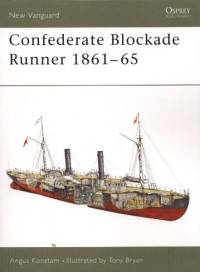 New
Vanguard 92, Confederate Blockade Runner 1861-65, by Angus Konstam, illustrated
by Tony Bryan, ISBN 1-84176-636-4, 48 pages. New
Vanguard 92, Confederate Blockade Runner 1861-65, by Angus Konstam, illustrated
by Tony Bryan, ISBN 1-84176-636-4, 48 pages.
Are you wondering why unarmed blockade runners should feature in the
New Vanguard series? Well, they did serve during a war and many of the
ones included here were owned by the Confederate government – which
seem like good reasons to include them. The evolution of their designs
from the beginning of the Union blockade to the end of the ACW is described,
with some interesting accounts of how they operated. The contemporary
illustrations are complemented by colour plates, whose commentaries give
potted histories of each ship shown. Some captured ships even became Union
blockaders! This is definitely one for ACW enthusiasts.
 Men-at-Arms
400, Wellington’s Peninsular Regiments (2) The Light Infantry, by
Mike Chappell with illustrations by the author, ISBN 1-84176-403-5, 48
pages. Men-at-Arms
400, Wellington’s Peninsular Regiments (2) The Light Infantry, by
Mike Chappell with illustrations by the author, ISBN 1-84176-403-5, 48
pages.
No, this isn’t about the 95th Rifles. It deals with all the other
light infantry units, both those raised in Britain and the Portuguese
and other allied troops. The evolution of the “light infantry”
idea is British service is described, with the training methods adopted
and the units’ battle experiences in the Peninsula. Their uniforms
are very well shown by the plates, as well as by contemporary illustrations
and by later ones (whose errors are pointed out in their captions) and
by photographs of surviving items. Recommended!
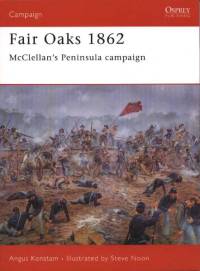 Campaign
124, Fair Oaks 1862, McClellan’s Peninsula campaign, by Angus Konstam,
illustrated by Steve Noon, ISBN 1-84176-680-1, 96 pages. Campaign
124, Fair Oaks 1862, McClellan’s Peninsula campaign, by Angus Konstam,
illustrated by Steve Noon, ISBN 1-84176-680-1, 96 pages.
This is a good addition to any ACW book collection, explaining how McClellan
failed to capture Richmond and end the war at a stroke. The whole campaign
is covered, including the Union landings at Fort Monroe to the siege of
Yorktown and the battle of Williamsburg before the main two-day action
at Five Oaks. The plates and contemporary illustrations give a good idea
of the terrain, field fortifications and uniforms, and the battlemaps
and bird’s-eye views make everything clear. Recommended.
|
|
 New
Vanguard 83, Armored Units of the Russian Civil War, White and Allied,
by D Bullock and A Deryabin, illustrated by A Aksenov, ISBN 1-84176-544-9,
48 pages.
New
Vanguard 83, Armored Units of the Russian Civil War, White and Allied,
by D Bullock and A Deryabin, illustrated by A Aksenov, ISBN 1-84176-544-9,
48 pages. Fortress
17, Troy c. 1700-1250 BC, by Nic Fields, illustrated by D Spedaliere and
S Sulemsohn Spedaliere, ISBN 1-84176-703-4, 64 pages.
Fortress
17, Troy c. 1700-1250 BC, by Nic Fields, illustrated by D Spedaliere and
S Sulemsohn Spedaliere, ISBN 1-84176-703-4, 64 pages. Warrior
72, Imperial Roman Legionary AD 161-284, by Ross Cowan, illustrated by
Angus McBride, ISBN 1-84176-601-1, 64 pages.
Warrior
72, Imperial Roman Legionary AD 161-284, by Ross Cowan, illustrated by
Angus McBride, ISBN 1-84176-601-1, 64 pages. Fortress
16, The Fortifications of Malta 1530-1945, by Charles Stephenson, illustrated
by Steve Noon, ISBN 1-84176-693-3, 64 pages.
Fortress
16, The Fortifications of Malta 1530-1945, by Charles Stephenson, illustrated
by Steve Noon, ISBN 1-84176-693-3, 64 pages. Fortress
15, Germany’ West Wall, The Siegfried Line, by Neil Short, illustrated
by Chris Taylor, ISBN 1-84176-678-X, 64 pages.
Fortress
15, Germany’ West Wall, The Siegfried Line, by Neil Short, illustrated
by Chris Taylor, ISBN 1-84176-678-X, 64 pages. New
Vanguard 92, Confederate Blockade Runner 1861-65, by Angus Konstam, illustrated
by Tony Bryan, ISBN 1-84176-636-4, 48 pages.
New
Vanguard 92, Confederate Blockade Runner 1861-65, by Angus Konstam, illustrated
by Tony Bryan, ISBN 1-84176-636-4, 48 pages. Men-at-Arms
400, Wellington’s Peninsular Regiments (2) The Light Infantry, by
Mike Chappell with illustrations by the author, ISBN 1-84176-403-5, 48
pages.
Men-at-Arms
400, Wellington’s Peninsular Regiments (2) The Light Infantry, by
Mike Chappell with illustrations by the author, ISBN 1-84176-403-5, 48
pages.